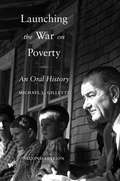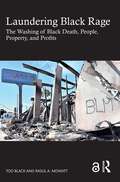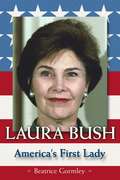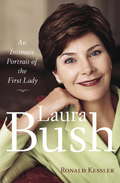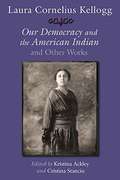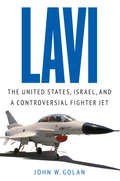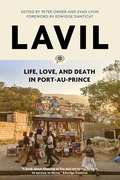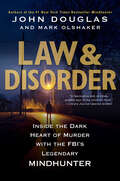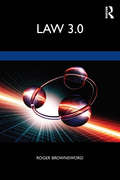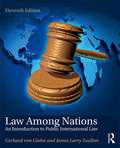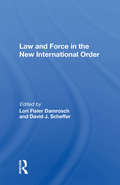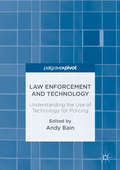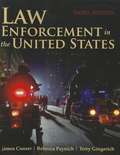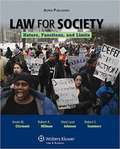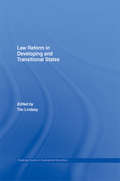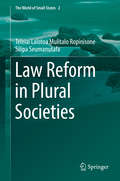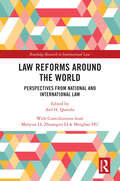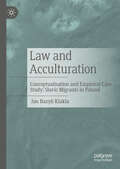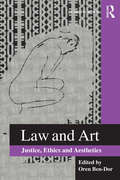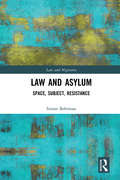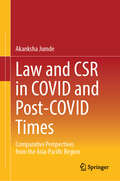- Table View
- List View
Launching the War on Poverty: An Oral History , 2nd Edition
by Michael L. GilletteHead Start, Job Corps, Foster Grandparents, College Work-Study, VISTA, Community Action, and the Legal Services Corporation are familiar programs, but their tumultuous beginning has been largely forgotten. Conceived amid the daring idealism of the 1960s, these programs originated as weapons in Lyndon Johnson's War on Poverty, an offensive spearheaded by a controversial new government agency. Within months, the Office of Economic Opportunity created an array of unconventional initiatives that empowered the poor, challenged the established order, and ultimately transformed the nation's attitudes.
Laundering Black Rage: The Washing of Black Death, People, Property, and Profits
by Rasul A Mowatt Too BlackLaundering Black Rage: The Washing of Black Death, People, Property, and Profits is a spatial and historical critique of the capitalist State that examines how Black Rage—conceived as a constructive and logical response to the conquest of resources, land, and human beings racialized as Black—is cleaned for the unyielding means of White capital. Interlacing political theory with international histories of Black rebellion, it presents a thoughtful challenge to the counterinsurgent tactics of the State that consistently convert Black Rage into a commodity to be bought, sold, and repressed. Laundering Black Rage investigates how the Rage directed at the police murder of George Floyd could be marshalled to funnel the Black Lives Matter movement into corporate advertising and questionable leadership, while increasing the police budgets inside the laundry cities of capital - largely with our consent.Essayist/Performer Too Black and Geographer Rasul A. Mowatt assert Black Rage as a threat to the flow of capital and the established order of things, which must therefore be managed by the process of laundering.Intertwining stories of Black resistance throughout the African diaspora, State building under capitalism, cities as sites of laundering, and the world making of empire, Laundering Black Rage also lays the groundwork for upending the laundering process through an anti-colonial struggle of reverse-laundering conquest. Relevant to studies of race and culture, history, politics, and the built environment, this pathbreaking work is essential reading for scholars and organizers enraged at capitalism and White supremacy laundering their work for nefarious means.
Laura Bush: An Intimate Portrait of the First Lady
by Ronald KesslerWhen Laura Bush moved into the White House on January 20, 2001, everyone wanted to know what kind of first lady she would be. Would she be like Mamie Eisenhower? Would she follow in Barbara Bush's footsteps? Would she be another Hillary Clinton? "I think I'll just be Laura Bush," she would say.
Laura Cornelius Kellogg: Our Democracy And The American Indian And Other Works (The Iroquois And Their Neighbors)
by Kristina Ackley Cristina StanciuLaura Cornelius Kellogg was an eloquent and fierce voice in early twentieth century Native American affairs. An organizer, author, playwright, performer, and linguist, Kellogg worked tirelessly for Wisconsin Oneida cultural self-determination when efforts to Americanize Native people reached their peak. She is best known for her extraordinary book Our Democracy and the American Indian (1920) and as a founding member of the Society of American Indians. In an era of government policies aimed at assimilating Indian peoples and erasing tribal identities, Kellogg supported a transition from federal paternalism to self-government. She strongly advocated for the restoration of tribal lands, which she considered vital for keeping Native nations together and for obtaining economic security and political autonomy. <p><p> Although Kellogg was a controversial figure, alternately criticized and championed by her contemporaries, her work has endured in Oneida community memory and among scholars in Native American studies, though it has not been available to a broader audience. Ackley and Stanciu resurrect her legacy in this comprehensive volume, which includes Kellogg’s writings, speeches, photographs, congressional testimonies, and coverage in national and international newspapers of the time. In an illuminating and richly detailed introduction, the editors show how Kellogg’s prescient thinking makes her one of the most compelling Native intellectuals of her time.
Lavi: The United States, Israel, and a Controversial Fighter Jet
by John W GolanThe Lavi fighter program, the largest weapons-development effort ever undertaken by the State of Israel, envisioned a new generation of high-performance aircraft. In a controversial strategy, Israel Aircraft Industries intended to develop and manufacture the fighters in Israel with American financial support. The sophisticated planes, developed in the mid-1980s, were unique in design and intended to make up the majority of the Israeli air force. Though considerable prestige and money were at stake, developmental costs increased and doubts arose as to whether the Lavi could indeed be the warplane it was meant to be. Eventually the program became a microcosm for the ambitions, fears, and internal divisions that shaped both the U.S.-Israeli relationship and Israeli society itself. But the fighter never made it to operational service, and until now, the full breadth and significance of the Lavi story have never been examined and presented. Lavi: The United States, Israel, and a Controversial Fighter Jet traces the evolution of the Lavi fighter from its genesis in the 1970s to its scrapping in August 1987. John W. Golan examines the roles of Israeli military icons and political leaders such as Ezer Weizman, Ariel Sharon, Menachem Begin, and Yitzhak Rabin in the program and in relation to their counterparts in the United States. On the American side, Golan traces the evolution of government policy toward the program, detailing the complex picture of the U.S. foreign policy apparatus and of U.S.-Israeli relations in general—from President Reagan’s public endorsement of the program on the White House lawn to Defense Secretary Caspar Weinberger’s unremitting attempts to cancel it in succeeding years.
Lavil: Life, Love and Death in Port-au-Prince, Haiti
by Peter Orner Evan LyonSeven years after the deadliest earthquake in the history of the Western Hemisphere struck Haiti, the island nation remains in crisis, all but ignored by the international community. At the center of this crisis is Lavil—“The City” in Kreyol, as Port-au-Prince is known to Haitians—the cultural, political, and economic capital of Haiti and home to over 2.5 million resilient souls. This immersive and engrossing oral history collection gives voice to the continuing struggle of Haitian people to live, love and prosper while trying to rebuild their city and country after disasters both natural and man-made. AMONG THE NARRATORS: Juslene, who moved to Port-au-Prince as a child for educational opportunities but was instead forced to work as a restavek—an unpaid servant—and who maintains unwavering hope despite the loss of her family when the city was destroyed. Johnny and Denis, a teacher and his younger brother, who spent years hustling for work and looking out for each other in one of the city’s sprawling post-earthquake tent camps. Lamothe, a wry and well-read expert on Haiti’s clean water crisis, who is one of the many Port-au-Prince citizens dedicated to rebuilding his city and nation.
Law & Disorder: Inside the Dark Heart of Murder
by Mark Olshaker John DouglasIt is mankind's most abominable crime: murder. No one is better acquainted with the subject and its wrenching challenges than John Douglas, the FBI's pioneer of criminal profiling, and the model for Agent Jack Crawford in The Silence of the Lambs. In this provocative and deeply personal book, the most prominent criminal investigator of our time offers a rare look into the workings not only of the justice system--but of his own heart and mind. Writing with award-winning partner Mark Olshaker, Douglas opens up about his most notorious and baffling cases--and shows what it's like to confront evil in its most monstrous form.
Law 3.0: Rules, Regulation, and Technology
by Roger BrownswordPutting technology front and centre in our thinking about law, this book introduces Law 3.0: the future of the legal landscape. Technology not only disrupts the traditional idea of what it is ‘to think like a lawyer,’ as per Law 1.0; it presents major challenges to regulators who are reasoning in a Law 2.0 mode. As this book demonstrates, the latest developments in technology offer regulators the possibility of employing a technical fix rather than just relying on rules – thus, we are introducing Law 3.0. Law 3.0 represents, so to speak, the state we are in and the conversation that we now need to have, and this book identifies some of the key points for discussion in that conversation. Thinking like a lawyer might continue to be associated with Law 1.0, but from 2020 onward, Law 3.0 is the conversation that we all need to join. And, as this book argues, law and the evolution of legal reasoning cannot be adequately understood unless we grasp the significance of technology in shaping both legal doctrine and our regulatory thinking. This is a book for those studying, or about to study, law – as well as others with interests in the legal, political, and social impact of technology.
Law Among Nations: An Introduction to Public International Law
by Gerhard Von Glahn James Larry TaulbeeOffering a more accessible alternative to casebooks and historical commentaries, Law Among Nations explains issues of international law by tracing the field's development and stressing key principles and processes. This comprehensive text eliminates the need for multiple books by combining discussions of theory and state practice with excerpts from landmark cases. Renowned for its rigorous approach and clear explanations, Law Among Nations remains the gold standard for undergraduate introductions to international law. Learning Goals Trace the development of International Law through key principles and processes. Illustrate important issues and theories using excerpts from landmark cases.
Law Among Nations: An Introduction to Public International Law
by Gerhard Von Glahn James Larry TaulbeeOffering a more accessible alternative to casebooks and historical commentaries, Law Among Nations explains issues of international law by tracing the field's development and stressing key principles, processes, and landmark cases. This comprehensive text eliminates the need for multiple books by combining discussions of theory and state practice with excerpts from landmark cases. The book has been updated in light of the continuing revolution in communication technology, the dense web of linkages between countries that involve individuals and bodies both formal and informal; and covers important and controversial areas such as human rights, the environment, and issues associated with the use of force. Renowned for its rigorous approach and clear explanations, Law Among Nations remains the gold standard for undergraduate introductions to international law. New to the Eleventh Edition Added or expanded coverage of timely issues in international law: Drones and their use in the air and in space Immigration Islamic views of international law Inviolability and the difference between diplomatic immunity and sovereignty, in light of the Benghazi attack Thoroughly rewritten chapters in areas of great change: International criminal law Just war and war crime law New cases, statutes, and treaties on many subjects
Law Among Nations: An Introduction to Public International Law
by James Larry Taulbee Gerhard von GlahnOffering a more accessible alternative to casebooks and historical commentaries, Law Among Nations explains issues of international law by tracing the field’s development and stressing key principles, processes, and landmark cases. This comprehensive text eliminates the need for multiple books by combining discussions of theory and state practice with excerpts from landmark cases. The book has been updated in light of the continuing revolution in communication technology; the dense web of linkages between countries that involve individuals and bodies both formal and informal; and important and controversial areas such as human rights, the environment, and issues associated with the use of force. Renowned for its rigorous approach and clear explanations, Law Among Nations remains the gold standard for undergraduate introductions to international law. New to the Twelfth Edition Added or expanded coverage of timely issues in international law: Drones and their use in the air and in space Outer space Cybercrime and responses The Julian Assange Case Environmental law Expanded discussion of space law Expanded discussion of conflict and non-state actors Final cases in the ICTY Thoroughly rewritten chapters on areas of great change: International Criminal Law Just War and War Crime Law International Economic Law (newly restored in response to reviews) International Environmental Law New cases, statutes, and treaties on many subjects
Law And Force In The New International Order
by Lori Fisler Damrosch David J. SchefferMomentous events of recent years have shown the tremendous potential for developing and applying international law, even in the area that has always presented the greatest challenge to the rule of law—the use of force. The collaborative response by the United States, the Soviet Union, and other major powers to the Iraqi army's invasion and occupation of Kuwait showed unprecedented unity on the relevance of international law, its rules, and its enforceability through decisions of the UN Security Council. What explains this historic convergence of views? What differences remain about the legality of using armed force in the new international order that is emerging with the end of the Cold War? Law and Force in the New International Order offers a timely and comprehensive inquiry into the growing number of situations where the temptation or necessity to use military force confronts the tenets of international law. Distinguished American and Soviet legal scholars and practitioners explore the idea of the primacy of law over politics, the notion held by some that U.S. military force may be applied for the sake of democracy at a time when Moscow has rejected the Brezhnev Doctrine, the tension between collective security and collective self-defense during the Iraq-Kuwait crisis, and the prospects for the use of force being authorized by the United Nations and regional organizations. The contributors also examine the vexing legal issues raised by interventions to protect human rights, to overthrow "illegitimate" regimes, and to combat international terrorism and drug trafficking; the restraints on the use of force promised by new arms control agreements; and the future role of the World Court and other tribunals in preventing or settling disputes involving the threat or use of force.
Law Enforcement and Technology: Understanding The Use Of Technology For Policing
by Andy BainThis edited book explores the history, development and use of technology in the policing of society, showing that technology plays a key, if not pivotal role in the work of law enforcement. The authors analyse several examples of technology in common use today, which include both officers' equipment and technology used by crime scene investigation teams. They discuss the supportive role that technology plays in the investigation process as well as the concerns that may arise from a reliance upon technological advances. The book offers the reader a unique look at the scholarly and professional experience, with chapters written by academic researchers, as well as a number practitioners from the field of policing. It is essential reading for all those interested in a constantly changing and evolving field with implications for both theory and practice.
Law Enforcement in the United States
by James A. Conser Rebecca Paynich Terry E. GingerichThis book is an ideal introduction to law enforcement and goes beyond discussions of local policing to examine how forces like technology, privatization, and the threat of terrorism are affecting law enforcement on local, state, and national levels. Readers will learn how these diverse and unpredictable forces are shaping the future of law enforcement in the United States, and will come away with the ability to think critically about law enforcement issues. New Material added to the revised and updated Third Edition:-"Stay Current" boxes throughout the text offer references and key search terms for further internet research-Updated figures, tables, charts and other statistical and descriptive information-A New chapter on socialization, advancement, and professionalism, including ethics and misconduct-A New chapter with emphasis on law enforcement's role in national security, homeland security, and protecting private assets-A separate chapter on "Policing Strategies, Tactics, and Daily Operations"-An expanded and updated chapter on management issues-Updated and expanded appendices
Law For Society: Nature, Functions, And Limits
by Katherine A. Currier Robert S. Summers Robert A. Hillman Sheri Lynn Johnson Kevin M. ClermontLaw for Society: Nature, Functions, and Limits offers an illuminating conceptual framework that looks at five basic legal instruments with which the law addresses the problems and goals of society. For any Introduction to Law course or as secondary reading in political science, criminal justice, or general studies, Law for Society breaks down the very concept of law to answer the questions: What is law? How does law work? What can law do and not do? The book addresses the nature of law, its problem-solving functions, and the limits on what law can accomplish.
Law Reform in Developing and Transitional States (Routledge Studies in Development Economics #54)
by Tim LindseyLaw reform in developing countries has become an increasingly topical subject in recent years. A critical issue is why so many law reform projects in developing economies are regarded by their sponsors and recipients as unsuccessful. This informative book: examines examples of law reform projects in post-socialist and post-authoritarian states in Asia identifies common problems proposes analytical frameworks for understanding the problems identified. Though parallels between Asian models and those in developing states elsewhere in the world are strong, the book has been developed to avoid suggestion that the issues covered are somehow peculiarly ‘Asian’- indeed, it is shown that cultural relativist approaches to Asia are unsustainable. This is an invaluable reference for those involved in the areas of development economics, Asian studies and comparative politics.
Law Reform in Plural Societies
by Teleiai Lalotoa Mulitalo Ropinisone Silipa SeumanutafaThis book asserts that the Pacific Islands continue to struggle with the colonial legacy of plural legal systems, comprising laws and legal institutions from both the common law and the customary legal system. It also investigates the extent to which customary principles and values are accommodated in legislation. Focusing on Samoa, the author argues that South Pacific countries continue to adopt a Western approach to law reform without considering legal pluralism, which often results in laws which are unsuitable and irrelevant to Samoa. In the context of this system of law making, effective law reform in Samoa can only be achieved where the law reform process recognises the legitimacy of the two primary legal systems. The book goes on to present a law reform process that is more relevant and suitable for law making in the Pacific Islands or any post-colonial societies.
Law Reforms around the World: Perspectives from National and International Law (Routledge Research in International Law)
by Asif H. QureshiEncapsulating Law Reform requires the creation of a discreet space occupied with normative self-generation, self-correction, and self-adaptation in the very anatomy of law and the architecture of legal systems. This ‘living dynamic trait’ should be a hallmark of the genetic material in the modern-day institution of law. This edited volume sheds light on Law Reform in its domestic, comparative, regional, and international settings. It examines the process of Law Reform and explains the need for a constant appraisal to keep its wheels optimally operational. The book takes a holistic approach to understanding Law Reform and calls for such an approach in the very process of Law Reform. It begins by looking at Law Reform processes from a theoretical perspective. Thereafter, it sheds light on domestic Law Reform processes in civil and common law legal systems. This is followed by a focus on Law Reform at the international level with a critical appraisal of the International Law Commission (ILC), drawing on its performance in international economic and environmental law. Included in this consideration is also the role played in Law Reform by the IMF, World Trade Organization/World Intellectual Property Organization, Multilateral Development Banks, and the African Union Commission on International Law. This volume should appeal to students, serious scholars, policy makers, judges, and the community of national and international lawyers interested in bringing effective reform in the national and international arenas.
Law against the State
by Brian Donahoe Zerrin Özlem Biner Julia Eckert Christian StrümpellThis collection of rich, empirically grounded case studies investigates the conditions and consequences of 'juridification' – the use of law by ordinary individuals as a form of protest against 'the state'. Starting from the actual practices of claimants, these case studies address the translation and interpretation of legal norms into local concepts, actions and practices in a way that highlights the social and cultural dynamism and multivocality of communities in their interaction with the law and legal norms. The contributors to this volume challenge the image of homogeneous and primordially norm-bound cultures that has been (unintentionally) perpetuated by some of the more prevalent treatments of law and culture. This volume highlights the heterogeneous geography of law and the ways boundaries between different legal bodies are transcended in struggles for rights. Contributions include case studies from South Africa, Malawi, Sierra Leone, Turkey, India, Papua New Guinea, Suriname, the Marshall Islands and Russia.
Law and Acculturation: Conceptualisation and Empirical Case Study: Slavic Migrants in Poland
by Jan Bazyli KlaklaThis book is one of the first attempts to directly explore the relationship between law and acculturation. By exploring the theoretical basis of the concept of culture, the ideas of law and various models of acculturation, it brings a nuanced theorization and problematization of the intricate connection between law and acculturation. It does this through theory and then presents the findings of the author’s qualitative empirical study conducted with a group of long-term Slavic migrants residing in Poland. The book culminates by demonstrating how the law can be integrated into one of the theoretical models of acculturation, specifically the Relative Acculturation Extended Model.
Law and Art: Justice, Ethics and Aesthetics
by Oren Ben-DorIn engaging with the full range of 'the arts', contributors to this volume consider the relationship between law, justice, the ethical and the aesthetic. Art continually informs the ethics of a legal theory concerned to address how theoretical abstractions and concrete oppressions overlook singularity and spontaneity. Indeed, the exercise of the legal role and the scholarly understanding of legal texts were classically defined as ars iuris - an art of law - which drew on the panoply of humanist disciplines, from philology to fine art. That tradition has fallen by the wayside, particularly in the wake of modernism. But approaching art in that way risks distorting the very inexpressibility to which art is attentive and responsive, whilst remaining a custodian of its mystery. The novelty and ambition of this book, then, is to elicit, in very different ways, styles and orientations, the importance of the relationship between law and art. What can law and art bring to one another, and what can their relationship tell us about how truth relates to power? The insights presented in this collection disturb and supplement conventional accounts of justice; inaugurating new possibilities for addressing the origin of violence in our world.
Law and Asylum: Space, Subject, Resistance (Law and Migration)
by Simon BehrmanIn contrast to the claim that refugee law has been a key in guaranteeing a space of protection for refugees, this book argues that law has been instrumental in eliminating spaces of protection, not just from one’s persecutors but also from the grasp of sovereign power. By uncovering certain fundamental aspects of asylum as practised in the past and in present day social movements, namely its concern with defining space rather than people and its role as a space of resistance or otherness to sovereign law, this book demonstrates that asylum has historically been antagonistic to law and vice versa. In contrast, twentieth-century refugee law was constructed precisely to ensure the effective management and control over the movements of forced migrants. To illustrate the complex ways in which these two paradigms – asylum and refugee law – interact with one another, this book examines their historical development and concludes with in-depth studies of the Sanctuary Movement in the United States and the Sans-Papiers of France. The book will appeal to researchers and students of refugee law and refugee studies; legal and political philosophy; ancient, medieval and modern legal history; and sociology of political movements.
Law and Authority in British Legal History, 1200–1900
by Mark GodfreyBy presenting original research into British legal history, this volume emphasises the historical shaping of the law by ideas of authority. The essays offer perspectives upon the way that ideas of authority underpinned the conceptualisation and interpretation of legal sources over time and became embedded in legal institutions. The contributors explore the basis of the authority of particular sources of law, such as legislation or court judgments, and highlight how this was affected by shifting ideas relating to concepts of sovereignty, religion, political legitimacy, the nature of law, equity and judicial interpretation. The analysis also encompasses ideas of authority which influenced the development of courts, remedies and jurisdictions, international aspects of legal authority when questions of foreign law or jurisdiction arose in British courts, the wider authority of systems of legal ideas such as natural law, the authority of legal treatises, and the relationship between history, law and legal thought.
Law and CSR in COVID and Post-COVID Times: Comparative Perspectives from the Asia-Pacific Region
by Akanksha JumdeThis book presents a comprehensive examination of the impact of COVID and post-COVID times on Corporate Social Responsibility (CSR) compliance and related legal frameworks in the Asia-Pacific region. The book utilizes various research methodologies to analyze corporates' responses to legislative and regulatory frameworks on CSR during the COVID pandemic. Focusing primarily on countries including China, India, Indonesia, and Australia, the book delves into the contrasting approaches taken by these nations in enforcing and regulating CSR. While some countries adopt hard law measures to ensure socially responsible behaviors, others rely on normative approaches such as the ASX Listing Rules. Through a combination of comparative doctrinal analysis and empirical socio-legal-based research methods, the book assesses the state of CSR compliance in selected countries. By analyzing companies' CSR disclosures and conducting interviews with stakeholders, the study identifies gaps in the existing legal literature. The book fills these gaps by offering practical recommendations to enhance policy development and strengthen the legal frameworks. It emphasizes the importance of corporate culture in influencing CSR-related activities. In conclusion, this book provides valuable insights into how companies can better comply with CSR regulations and improve their societal impact.
